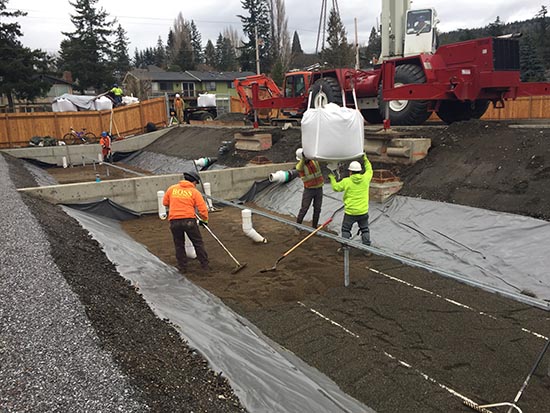|
Subscribe / Renew |
|
|
Contact Us |
|
| ► Subscribe to our Free Weekly Newsletter | |
| home | Welcome, sign in or click here to subscribe. | login |
Construction
| |
 |
February 6, 2023
Best In State: Gold Award
Unique Or Innovative Application Of New Or Existing Techniques

Herrera Environmental Consultants
Project: Park Place Stormwater Facility rebuild
Client: City of Bellingham
The city of Bellingham hired Herrera to solve issues with too much phosphorous in Lake Whatcom and to maximize the potential of the Park Place Stormwater Facility, which receives flows from one-third of the Lake Whatcom watershed. The solution included Herrera’s team developing a high-performance, cost-effective stormwater treatment technology optimized for phosphorus removal that is scalable for projects around Washington state.
Herrera teamed with Western Washington University for the initial R&D phase to conduct laboratory column experiments, evaluating over 14 media components and 10 different media blends. After experimenting with several media blends, the team identified the optimal combination of components for hydraulics, phosphorus removal, and cost, naming the new technology the Phosphorus-Optimized Stormwater Treatment (POST) system.
Following the pilot scale testing, Herrera designed and prepared bid-ready construction documents for a total reconstruction of the Park Place Stormwater Facility using the POST system to increase phosphorus removal performance for approximately 180 acres (35% of the Lake Whatcom watershed within the city limits of Bellingham).
To maximize flexibility and allow the use of the POST system across the Lake Whatcom basin, the city opted to get the POST system approved through the state Department of Ecology’s TAPE (Technology Assessment Protocol — Ecology) verification program. After 18 months of pilot scale field testing, the POST system achieved a general use level designation from Ecology for phosphorus and sediment removal. In addition, a new design guide will assist others in implementing this new technology.
With the Park Place Stormwater Facility completed, the city of Bellingham can monitor the facility’s pollutant reduction performance starting this fall. The new systems will deploy automated samplers, flow sensors, a rain gauge, telemetry, and an intelligent logging and control system to accurately assess the water quantity and quality at both the inlet and outlet of the facility. The collected data will verify the facility’s performance and document the removal of phosphorus.
Other Stories:
- National Finalist: Platinum Award
Transportation - Best In State: Gold Award
Future Value To The Engineering Profession - Best In State: Gold Award
Social, Economic And Sustainable Design - Best In State: Gold Award
Complexity - Best In State: Gold Award
Exceeding Client/Owner Expectations - National Finalist: Gold Award
Surveying/Mapping Technology - National Finalist: Gold Award
Special Projects - National Finalist: Gold Award
Structural Systems - National Finalist: Gold Award
Structural Systems - Diversity And Inclusion Award: Mid-Sized Firm
- Diversity And Inclusion Award: Large Firm
- Engineer of the Year
- National Finalist: Gold Award
Transportation


